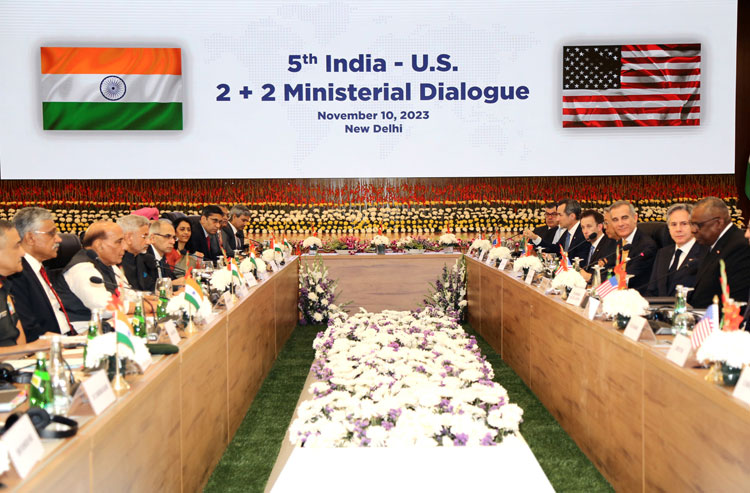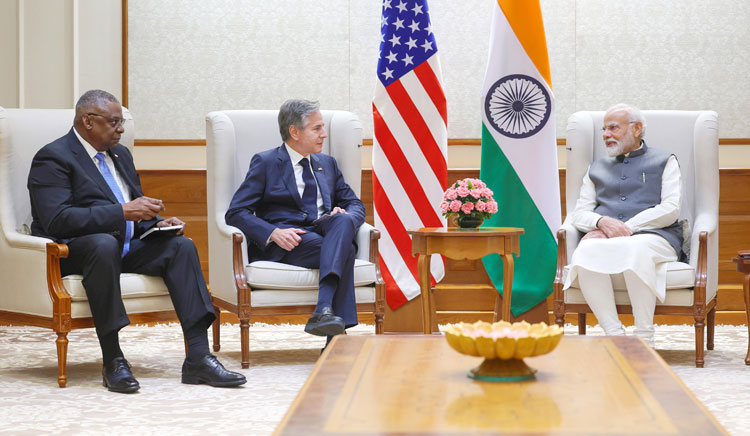INDIAN ARMED FORCES CHIEFS ON OUR RELENTLESS AND FOCUSED PUBLISHING EFFORTS

SP Guide Publications puts forth a well compiled articulation of issues, pursuits and accomplishments of the Indian Army, over the years

"Over the past 60 years, the growth of SP Guide Publications has mirrored the rising stature of Indian Navy. Its well-researched and informative magazines on Defence and Aerospace sector have served to shape an educated opinion of our military personnel, policy makers and the public alike. I wish SP's Publication team continued success, fair winds and following seas in all future endeavour!"

Since, its inception in 1964, SP Guide Publications has consistently demonstrated commitment to high-quality journalism in the aerospace and defence sectors, earning a well-deserved reputation as Asia's largest media house in this domain. I wish SP Guide Publications continued success in its pursuit of excellence.
- Indian Air Force Aims for Full Indigenous Inventory by 2047 — Air Chief Marshal A.P. Singh
- Rajnath Singh assumes charge as Defence Minister for the second consecutive term
- Interim Defence Budget 2024-25 — An Analysis
- Union Defence budget 2024
- Prime Minister Modi Flies in the LCA Tejas
- New Chapter in India-Italy Defence Ties
- Airpower beyond Boundaries
India-US Strategic Relations – In Robust Health
At the latest 2+2 Ministerial dialogue, India and the US forge a resilient alliance and unveil a multi-Faceted partnership for defence, innovation, and global security

With growing convergence on strategic issues and need to cooperate and work together to counter challenges being faced from China, India and US reaffirmed their commitment to check it's aggressive behaviour by further intensifying joint moves in the Indo-Pacific region, through mechanisms like QUAD. However, Indo-US relations are not limited to China related considerations and as the outcome of the latest 2+2 ministerial dialogue, held on November 10, has shown that bilateral relations have become multi-faceted, indicating the robust health of the partnership.
Diversification of Bilateral Relations
Besides taking roots in defence industrial cooperation, the relationship is now expanding to closer interactions between armed forces. To further develop closer interoperability, US and India are setting up new liaison positions to facilitate seamless communication and cooperation between their armed forces. The ministers welcomed grant of full membership to India in the multinational combined maritime forces (CMF), which is headquartered in Bahrain. The two sides are also discussing ways and means to maximise the shared benefits of the Logistics and Exchange memorandum agreement (LEMOA) and are identifying reciprocal steps both countries can take to enhance the reach of their respective militaries.
India and the US reaffirm their commitment to countering challenges from China, demonstrating joint strategic moves in the Indo-Pacific region through collaborative mechanisms like QUAD
The Indo-US 2+2 dialogue of foreign and defence ministers has now entered into fifth year during which the four ministers have shown green flag to go ahead with the proposal to jointly produce the GE F414 Jet engines in India. These will power the Indian LCA Mk2 fighter, a proposition unthinkable just two and half decades ago when US seized one of the LCAs sent to USA for fitting GE F404 engines. During those days, US had sanctioned Indian defence firms after Indian 1998 Pokaran nuclear tests. This significant development was accompanied with another announcement that India would consider making the US Stryker armoured vehicles in India. The Indian interlocutors gave a go ahead to US proposal to jointly develop and manufacture Stryker armoured fighting vehicles. The combat vehicle presently supplied to Ukraine army has impressed Indian army which is giving a tough time to the Russians. India also hopes to produce them with US technical assistance and pose a challenge to Chinese and Pakistani armoured vehicles in the battlefield.
Comprehensive Global Strategic Partnership
The 2+2 dialogue has transformed the Indo-US relations across domains based on trust and mutual understanding. After the 5th 2+2 dialogue the four Indo-US ministers Dr S. Jaishankar, Anthony Blinken, Rajnath Singh and Lloyd Austin, together reaffirmed the importance of Indo-US comprehensive global strategic partnership in ensuring international peace and security. This may be construed as an indirect reference to joint role the two countries are playing together in ensuring peace and stability not only in the Indo-Pacific region but also in the Indian Ocean maritime arena, where China plans to make a splash through the Gwadar port in Pakistan besides the Myanmar and Bangladeshi ports being developed by the Chinese.
The latest 2+2 ministerial dialogue showcases the multi-faceted nature of Indo-US relations, extending beyond concerns related to China and illustrating the robust health of this strategic partnership
The 2+2 dialogue mechanism has pushed India-US bilateral relations to a new height and grown in strength each year because of consensus on various issues and agreements and decisions taken during annual dialogue. Defence sector has emerged as principal beneficiary, which is set to see many joint ventures and transfer of technologies. The 2+2 dialogue seems to have put the bilateral relations on auto-pilot and the officials and defence industry community of both the countries now are guided by commitment expressed at the highest level.

The latest dialogue held in New Delhi on November 10, will help bring the defence cooperation agreements between defence industry of two nations at the ground level and push the momentum of its execution with faster speed. India hopes to acquire cutting edge defence technology and US hopes to dominate a huge Indian defence market. India has been acquiring defence equipment technology from Soviet Union in the beginning and later from European countries but the Indo-US bonhomie promises to leave them behind with multi-billion dollars project in the pipeline for joint development and production, which will enrich Indian armed forces with devastating fire power.
A paradigm shift in defence cooperation unfolds with the joint production of GE F414 Jet engines and the prospective manufacturing of US Stryker armoured vehicles in India, marking significant advancements in defence technology
The four ministers took note of the breadth of partnerships under India-US Defence Acceleration Ecosystem (INDUS-X), which was launched in June, 2023 which held its first investors strategy session just two days before 2+2 dialogue on November 8, 2023 in New Delhi. The event provided an opportunity for private investors to mobilise capital for funding innovation in cutting edge technology to address critical security needs. According to an official of the Indian ministry of external affairs, the meeting will enable a high level review of progress being made in "cross-cutting aspects ofdefence and security cooperation, technology value chain collaborations and people to people ties. According to officials, at the event the two defence innovations challenge were discussed. These were launched under INDUS-X on underwater communications and oil spill detection, which were under advanced stages. Presently the review of applications from the startups of both sides are currently underway. Officials indicated that 297 startups have registered through iDEX. Acceptance of necessity has been granted in around 30 cases of which ten contracts have been signed. The INDUS investors meet brought together stakeholders of both sides including startups,investors, incubators and industry representatives to discuss collaborative agendas and opportunities in the defence sector. The US and Indian defence ministers noted that INDUS-X joint challenges initiative will unleash the talent and innovative drive of the commercial sectors in both countries, which will strengthen the respective defence industry ecosystems.

Defence Industrial Cooperation and Innovation
The 2+2 dialogue also reaffirmed the Roadmap for Defence Industrial cooperation as a catalyst for strengthening India's defence capabilities, enhancing its indigenous defence production, facilitating technology sharing and promoting supply chain resilience. In this backdrop, the four ministers appreciated the commencement of negotiations for a commercial agreement between General Electric (GE) Aerospace and Hindustan Aeronautics Limited to manufacture GE F414 engines in India. Such partnerships exemplify the type of defence industrial cooperation that the two countries look forward to pursuing as an enduring pillar of defence partnership. The Indian and American defence ministers also expressed hope that defence companies of both the countries will propose additional projects to develop and produce systems in the priority areas established in the group.

The four ministers also took note of the progress achieved towards co-production and co-development of defence systems. They also noted their mutual interest to co-develop and co-produce the ground mobility systems, as they bring the two countries respective defence sectors closer together while enhancing India's capabilities. The official statement said that they look forward to additional proposals from Indian and US companies to develop and co-produce systems in the priority areas established in the roadmap.
Progress under the India-US Defence Acceleration Ecosystem (INDUS-X) highlights a commitment to innovation, cutting-edge technology, and collaborative defence systems development, shaping the future of Indo-US defence cooperation
Besides cooperation in defence industry, both sides reaffirmed commitment to spur investment in India's growing Maintenance, Repair and Overhaul (MRO) sector, which encompasses aircraft maintenance and mid-voyage repair of US naval vessels. They welcomed commitments from the US industry to further increase MRO capabilities, including for the repair of aircraft and unmanned aerial vehicles.

Both sides also pledged to address export control issues while expanding defence industrial cooperation and supporting India's goals of emerging as a global defence hub. In this regard, both sides are holding talks on export control and technology transfers under the strategic trade dialogue and its affiliated working groups. India and US are reported to have differences over export control laws that complicate technology transfers.
A key priority of Indo-US Defence industrial cooperation has been identified as finalisation of a Security of Supply Agreement (SOSA), which aims to further integrate defence industrial ecosystems of both countries while strengthening supply chain resilience. India-US defence partnerships are now being lifted to a level, where the two can not only mutually support each other as a friend but are also moving in a direction, where the two countries can work together to safeguard their common interests. The relations are guided with this motive, which has emerged unharmed in spite of recent global events, from Russia Ukraine war to Israel-Hamas and Canada-India disputes relevant to the bilateral relations.
(The author is a Senior Journalist and Strategic Affairs Analyst)





